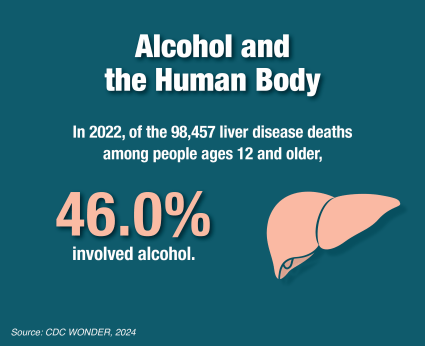Alcohol and the Human Body
Image

- Of the 98,457 liver disease deaths among people ages 12 and older in 2022, 46.0% involved alcohol. Among males, 60,412 liver disease deaths occurred, with 48.6% involving alcohol. Among females, 38,063 liver disease deaths occurred, with 41.8% involving alcohol.1
- Among all cirrhosis deaths in 2019, 50.3% were alcohol related. The percentage of alcohol-associated cirrhosis deaths was highest (at 80.9%) among adults ages 25 to 34, followed by adults ages 35 to 44 (at 75.4%).2
- The number of patients with alcohol-associated liver disease (ALD) who were listed for liver transplant increased by 63% from 2007 to 2017.3 In 2016, ALD replaced hepatitis C virus infection as the leading cause of liver transplantation due to chronic liver disease.4
- In patients with severe alcohol-associated hepatitis, the prognosis is poor. Mortality is 20-40% within 3 months of diagnosis, and up to 70% for the subset of diagnosed patients who don’t respond to corticosteroids.5
- Recent estimates for the United States indicate that 5.6% of cancer cases and 4.0% of cancer deaths are attributable to alcohol consumption.6
- Research has shown that people who misuse alcohol have a greater risk of liver disease, heart disease, depression, stroke, and stomach bleeding, as well as cancers of the oral cavity, esophagus, larynx, pharynx, liver, colon, and rectum.7-10 These individuals may also have problems managing conditions such as diabetes, high blood pressure, pain, and sleep disorders. Misusing alcohol may also increase the likelihood of unsafe sexual behavior.
- Alcohol consumption is associated with increased risk of drowning and injuries from violence, falls, and motor vehicle crashes.11-14 Alcohol consumption is also associated with an increased risk of female breast cancer, oropharyngeal cancer, esophageal cancer (especially in individuals who inherit a deficiency in an enzyme involved in alcohol metabolism), and harmful medication interactions.10,15-20 Alcohol consumption has been linked to risk for fetal alcohol spectrum disorders in the offspring of women who consume alcohol during pregnancy.21
- The NIAAA Healthcare Professional’s Core Resource provides additional information about the effects of alcohol on the human body.

